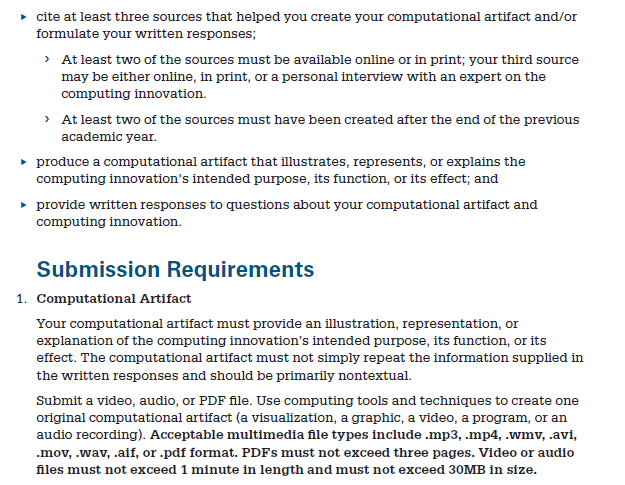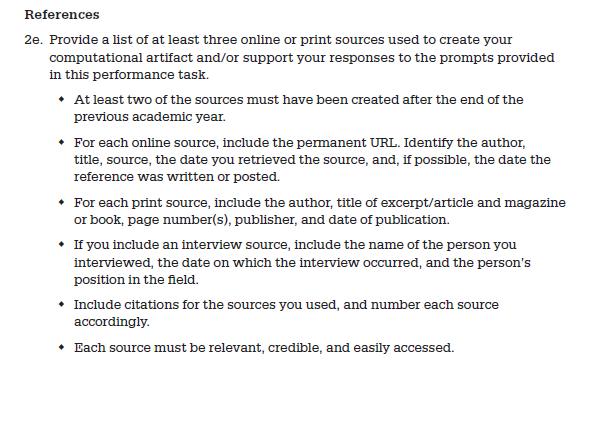
Welcome to
AP Computer Science Principles
This week we are going to be working on the following:
AP
Computer Science Class – Unit 2 – Digital Information
To Think; To Develop Problem-Solving Skills; To Discover; and To
Create;
Learning
to Compute and Computing to Learn
Classroom
Protocol:
This is where you will come every day to find out what we are
going to do in class for that day. Every day you are to come to your Quia class
web page upon arriving to class, go to your class web page, and follow the
directions for today.
Homework
Policy:
All assignments will be due on the deadline date given. It is the
responsibility for all students to complete their assignments on time. Any
assignments received late will not be accepted and a grade will not be given for
that assignment.
Accessing
your Class Weekly Agenda:
Each
week’s agenda and assignments will be updated and posted on your Quia class
web page on a weekly basis. Previous
weeks Assignments/Agendas will be provided with a link at the end of the current
week’s Class Web Page in case you need to revisit due to an absence, or
you’re required to make up, or catch up on your course assignments.
Homework Assignment:
Daily
homework assignments may be found at the end of each day’s agenda.
F
Day – Lunch 11:35 – 11:59
IMPORTANT DATES:
Saturday December 10 (8 –
12) Grafton - AP Study Session
Saturday March 4 (8 – 12) Millbury - AP Study Session
In
class Explore Performance Task and Submission Dates:
Task
Begins: Monday December 5, 2016 (Total 9.5 Classes)
This
Week’s Agenda:
Your
Explore Performance Task Begins Today!
Continuation to UNIT 2: Digital
Information:
This
unit further explores the ways that digital information is encoded, represented
and manipulated. Being able to digitally manipulate data, visualize it, and
identify patterns, trends and possible meanings are important practical skills
that computer scientists do every day. Understanding where data comes from,
having intuitions about what could be learned or extracted from it, and being
able to use computational tools to manipulate data and communicate about it are
the primary skills addressed in the unit.
Chapter
1: Encoding and Compressing Complex Information
Big Questions
·
Are the ways in which digital information
is encoded more laws of nature or man made?
·
What kinds of limitations does the binary
encoding of information impose on what can be represented inside a computer?
·
How accurately can human experience and
perception be captured or reflected in digital information?
Enduring Understandings
·
1.1 Creative development can be an
essential process for creating computational artifacts.
·
1.3 Computing can extend traditional forms
of human expression and experience.
·
2.1 A variety of abstractions built upon
binary sequences can be used to represent all digital data.
·
3.3 There are trade offs when representing
information as digital data.
Monday 12-4-16 – Day C - Friday 12-9-16 – Day G
For the next 9.5 Classes, 8 hours of class time you will be
working on your first AP CSP college board Performance Task. This is an
independent assignment. Please plan and use your time wisely and use the Digital
Portfolio online resources including the Explore Performance Task Rubric as a
guide to fulfilling the Explore Performance Task Requirements.
Explore Performance Task Rubric
Please
review the following description of an Explore Performance task:






What
is a Computational Artifact?
There are a number of widely available computational tools
students can use to create computational artifacts for this task.
A Computational Artifact
is a visualization, a graphic, a video, a program, or an audio recording that
students create using a computer. Your artifact creations show a creative
expression or provide the viewer with new insight or knowledge.
Effective
artifacts include: visual, graphical, and/or audio content to help a reader
understand the purpose of a computing innovation; and the use of communications
media, such as animations, comic strips, infographics, and/or public service
announcements, to illustrate the purpose of a computing innovation.
Good
luck and always do the best you can and most of all have fun and enjoy!
Ticket
to Leave:
In
order to prepare you for your two AP CSP college-board performance tasks we need
to get use to reflecting on our daily work and experiences. This is a skill that
will prove to be useful when you go on to college, enter the workforce, and even
in every aspect of your everyday life. Every
day at the end of class you should save your work, open up your journal, put
down today’s date, and provide the following information.
1. Provide at least on new thing that you learned today – Refer to today’s Objectives
2. What did you accomplish today?
3. Indicate any problems or obstacles you experienced
4. How did you solve the problems or obstacles that you experienced?
Feel
free to provide screen shots of your daily work in order to illustrate your
day’s activities. Windows provides a Snipping
Tool within its provided Accessories that may be used for this purpose.
Homework:
Preparation for Explore Performane Task:
Ø
Look
for a computing innovation that will allow you to meet all requirements of the
Explore Performance Task. Begin thinking about the digital tools you will use to
create your innovation artifact.
Explore
Performance Task Rubric
Ø
Every
day for the next couple of weeks please do the following as part of our chapter
on Data Collection:
Fill
out this form EVERY DAY, or as frequently as possible over the next few weeks.
We will look at the results more fully later on in this unit
AND
Ø
Complete
your ticket to leave journal entry.
Thanks for a great
week!
Mr. PC
Every day for the next
couple of weeks please do the following as part of our chapter on Data
Collection:
Fill
out this form EVERY DAY, or as frequently as possible over the next few weeks.
We will look at the results more fully in Lesson 7 of this unit.
Explore
Performance Task Rubric
More Resources for
finding computing innovations:
http://www.pbslearningmedia.org/
Tools
for building computing artifacts:
http://cooltoolsforschools.wikispaces.com/
To Due: Create Digital
Portfolios for Performance Tasks Submissions. Our goal is to complete our
Explore Performance Task before the end of 2016.
·
Begin
preparing for the May 5th Exam with practice exam questions from AP training
google drive and the career board. Use online student response system for class
review and discussion.
Unit
1 Vocabulary
Setting up the APP
Inventor and Emulator for Testing
You can set up App Inventor and start building apps in minutes.
The Designer and Blocks Editor now run completely in the browser (aka
the cloud). To see your app on a device while you build it (also called
"Live Testing"), you'll need to follow the steps below.
If you are using an Android device and you have
a wireless internet connection, you can
start building apps without downloading any software to your computer. You will
need to install the App Inventor Companion App for your device. Choose Option
One below. This
option is STRONGLY RECOMMENDED
For Class Use this Option: If you do not have an Android
device,
you'll need to install software on your computer so that you can use the
on-screen Android emulator. Choose Option Two below.
If you do not have a wireless internet
connection, you'll need to install software on your computer so that you
can connect to your Android device over USB. Choose Option
Three below. The
USB Connection option can be tricky, especially on Windows. Use this as a last
resort.
If you have
a computer, an Android device, and a WiFi connection, this is the easiest way to
test your apps.
If you don’t have an Android phone or tablet handy, you can
still use App Inventor. Have a class of 30 students? Have them work primarily on
emulators and share a few devices.
Some
firewalls within schools and organizations disallow the type of WiFi connection
required. If WiFi doesn’t work for you, try USB.
Note: Internet Explorer is not supported. We recommend Chrome or Firefox.
2)Check out the Designer and Blocks Editor Overview
3)
Setup Review the
following Beginner Tutorials
Click Here to
Access Your Development Environment